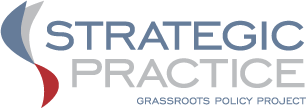
Welcome to Strategic Practice
Welcome to GPP’s new website on strategic practice. We’re launching this site as a place for dialog and reflection about a long-standing question: how do social movement organizations make their day-to-day work – including immediate campaigns – add up to more, to advance long-term goals for social transformation?
As part of this dialog, we will share a number of case studies from our work in the field, reflecting upon what we’re learning about the tools and concepts we bring to groups’ strategy development work. To kick things off, we are starting with a case study written for GPP by Phillip Cryan about ISAIAH’s strategic practice.
Here’s an illustration of what we mean by activities and processes that can come together as strategic practice, based on the ISAIAH case study:
- A bold, long-term vision for social transformation is at the heart of the organization’s work.
- The organization has a systematic and disciplined organizing methodology.
- Leadership development is central to all organizing practice.
- The work is about both social and personal transformation.
- Strategies are rooted in a deliberate power analysis that understands both organization and ideas as forms of power.
- Investments are made in alliance-building, to achieve results that no single organization can accomplish on its own.
- To achieve major changes, groups and their leaders must sometimes take risks.
What, exactly, do we mean by ‘strategic practice?’ And what does it look like for different kinds of organizations and networks? Simply put, it is the common sense idea that we have to relate tactics to strategy and strategic goals. The difficultly with this common sense idea is that it isn’t easy to know how to align immediate work with long-term goals, and there are many barriers to doing so. What kinds of choices must organizations make in order to be effective in the short-term and at the same time take on this challenge? And what kinds of tools and practices help groups to "mind the gap" between short-term and long-term?
For some groups, strategic practice is a way of cultivating and augmenting existing activities, many of which may be happening in less deliberate or coordinated ways, such as: movement-level strategic analysis (for example, ‘naming the moment,’ and incorporating lessons from social movement history), power analysis, worldview work (including clarifying what we believe and why), racial justice work (which needs to inform all aspects of a groups’ work), building organizational capacity, investing in leadership development and participating in alliances, coalitions and networks.
Strategic practice is not about having a fixed construct or plan. It is about evolving and emerging processes that are constantly evaluated and re-calibrated. We encourage groups to become ‘learning organizations’ with the self-critical capacity to think deeply about their work and make changes based on what they are learning.
What does strategic practice have to do with the moment we are in right now, where so much in flux? By taking the long view, we can see lots of openings and opportunities, on multiple fronts, in the midst of today’s political and economic set-backs. For example, more and more groups are looking way beyond their usual issue areas, toward forging a new, more democratic social contract where economic and social relationships are based in equity, shared prosperity and sustainability. And lots of new people are getting energized and involved, in a variety of ways, inspired by events taking place around the world. From Cairo to Madison, from London to New Delhi, from Ohio to Wall Street, we see a new determination to rebuild bottom-up democracy and break up the forces that have concentrated global wealth and power into the hands of a few. In order to take advantage of these openings, social movement groups need to orient their short-term actions toward advancing long-term strategy.
We hope this emerging ‘strategic practice’ framework will help support groups’ efforts to bring together elements of organizing and network-building, to capture the possibilities of the moment and build capacity for the long-haul.
Let us know what you think: what are you seeing in your organization or in others, that reflects strategic practice? How do these elements compare? Would you add elements, or state these differently? Please share your thoughts and examples with us.
Our writings on strategic practice:

